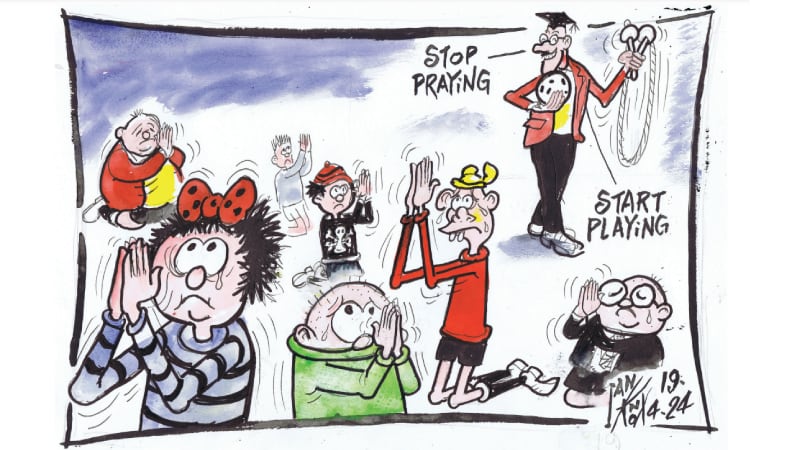T here are now no more than 15 goslings alive in the Waterworks when in previous years there were 30 to 50. There are perhaps seven cygnets left compared to last year’s 18, and all the ducklings are already dead.
Focusing on the geese, symbol of Irishness and the lynchpin of the park’s fowl, by this stage most of the goslings have gained enough size to no longer fall to their primary threat – the predation of crows – but have many challenges ahead not least of which is learning to fly and navigate. Until they fly they will be getting picked off by the otters. The odds are now heavily against any of this year’s generation of geese (and swans, ducks already dead remember) surviving to maturity, an unprecedented event in the park that may have serious consequences.
These are all natural hazards geese would normally face, and act along with the parks geography to limit the population, but as we can infer from the excess deaths combined with the increased footfall this year, human activity is clearly a contributing factor and now that factor has almost wiped this generation out already, one month since hatching began, and during the best weather for it in years.
Observe the resident geese parenting and you will see them protecting their young from a tag-team of preying crows, not always successfully. Nevertheless it is something they can defend against, even learning new strategies and improving with experience. Now add a marching dog into the situation, barging into somewhere they’re not wanted, by right should not be, terrorising the infant geese and causing a chaotic response completely negating the parents’ very best efforts to raise their children. It is effectively irrelevant here whether in the excitement the dog might bite or not, its presence alone does damage. The crows get all-too-easy pickings, and will remember that dog in future as a provider of such opportunities, while the geese have no chance. There is absolutely nothing they can ever do but suffer this recurring tragedy.
The only protection the fowl have from this is the parks bylaws which require dogs on a lead, under control at all times, and that they never bother the wildlife. Other parks, including Alexandra Park do not have these requirements, so there are less destructive options available for those who wish to walk the dog unleashed.
In a managed park in which fowl breed protected by law, when a dog’s behaviour in breach of that law causes the death of fowl, that dog and its owner are directly responsible for the situation in which the Waterworks primary assets are being destroyed.
If the Waterworks wildlife continues to be just taken for granted this rare gift will be lost, and the swans will join the gondolas in Belfast’s urban mythology.
C Ó Gallchobhair
Belfast BT15
Space surrounding church sanctuary mustn’t become platform for entertainment
Wilson Burgess’s comment (June 8) on the videos of the playing of The Sash and an Irish dance from parish churches that went ‘viral’ in recent weeks, refers to the clips as “an unfortunate intrusion by way of musical expression” to which his commitment to the Eucharistic presence was ‘subjected’. The videos also raise the issue of whether there is an apparent disconnect between our understanding of what happens in our church buildings and the conduct we should consequently observe. Regardless of the rapturous hype the clips stirred up because of the good cheer they generated and for which they were intended, the videos themselves have at the same time risked sending out a false message.
Because of the Catholic Church’s deeply held conviction of the Real Presence of Jesus Christ in the Holy Sacrament of the Eucharist, it follows that one’s behaviour and demeanour in the church building must reflect this. We are encouraged to observe the need for prayerful participation during Mass, to genuflect when coming to the altar, to kneel at the consecration, to stand to greet the Gospel or to profess our faith, and to refrain from chatter. The space inside our church buildings and most of all the space in and around the sanctuary, are first and foremost, sacred spaces. This, therefore, should incline us to be mindful of the reverence we ought to show for the real presence of Christ in our midst. It is clear that the dancing happened after Mass had been celebrated. This, however, is not the point. The space surrounding the sanctuary – while the Blessed Sacrament remains in the Tabernacle – must not become a platform for entertainment. To this end, I would question whether such entertainment has any place in the church building for it surely compromises the reverence that befits the Real Presence.
LYDIA HENRY
East Sussex, England
Addressing loneliness
One in five people across all ages in Northern Ireland report feeling lonely always or often, from children to those in later life. The Coronavirus outbreak risks making this problem worse, so as this year’s Loneliness Awareness Week (June 15-19) begins, it’s critical that we look at the collective action needed to tackle loneliness during the crisis and beyond.
Government’s priority has rightly been to stop the spread of Coronavirus, but it is likely that those who were already at increased risk of becoming lonely prior to Covid-19 – such as those in ill-health, carers, parents or bereaved people – may be more vulnerable than ever due to lockdown and social distancing measures. Prolonged and unwanted loneliness can have serious implications for our physical and mental wellbeing.
In response to Covid-19, the Action Group on Loneliness Policy is calling on the executive to take urgent action to help address loneliness across NI. We want to see a ministerial lead appointed to coordinate action across Stormont departments to tackle loneliness, with the funding needed to make a difference. This should be supported by an implementation group of charities, businesses, health bodies and other relevant sectors.
By taking these steps the executive can make a real difference to lead and coordinate tackling loneliness throughout Northern Ireland over the coming months.
CHARLENE BROOKS
Action Group on Loneliness Policy
Mitchel statue should be removed
I strongly support the online petition to remove the statue of Young Irelander, John Mitchel from a street in Newry (June 9).
While Mitchel was a strong advocate for Irish independence, he was also an unapologetic defender of slavery in pre-civil war United States, and, when the civil war eventually happened, two of his sons forfeited their lives for the pro-slavery confederate states. Such was his commitment to the retention of slavery, Mitchel even advocated for the return of slave ships. In his weekly newspaper, ironically called Citizen, Mitchel was critical of “bad Irishmen” who favoured the anti-slavery cause in the United States.
In his white supremacist world view, elevating blacks to the same status as white men risked jeopardising “the present freedom of a nation of white men”.
Mitchel is often lauded as the champion of Irish independence and freedom from the stranglehold of British colonial rule.
That is one aspect of the man. Yet, he was also a racist and was extreme in his defence of slavery. This statue should be removed. Its continued presence in Newry tarnishes the history of those who sought freedom from colonial slavery.
PAT ARMSTRONG
Derry City







